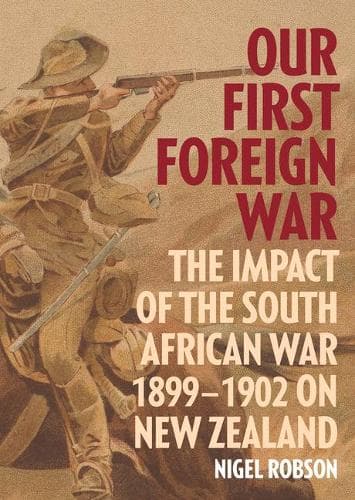Review: Our First Foreign War: The impact of the South African War 1899–1902 on New Zealand
Reviewed by David Littlewood
For a people whose involvement in conflict is often said to have exerted a major influence on their national identity and characteristics, New Zealanders have shown remarkably little interest in several of their overseas wars. Nowhere is this more apparent than for the 1899-1902 South African War. Only a handful of scholars have examined the conflict in any real detail, with the common tendency being to skirt over it as a minor prelude to the cataclysmic events of 1914-1918.
But as Nigel Robson demonstrates in this very welcome study, the course and legacies of New Zealand’s involvement in the South African War were significant enough to demand attention on their own merits. Robson provides a wide-ranging analysis of the conflict’s impacts. While two chapters examine how the 6500 soldiers New Zealand sent to the war conducted themselves on and off the battlefield, this is not primarily a history of tactics and campaigns.
The majority of the content instead focuses on domestic reactions to the war, the physical and emotional bonds many New Zealanders had to the British Empire, the experiences of returning veterans and how the conflict affected different sectors of the New Zealand economy. A particularly well-executed chapter looks at the responses of Māori to the war, with some iwi keen to contribute soldiers to the British cause, and many others taking part in fundraising and other patriotic activities. Despite Premier Seddon being a vocal supporter of their involvement, and despite several managing to enlist as individuals, the imperial authorities repeatedly blocked efforts to include groups of Māori within the ten New Zealand contingents that sailed for South Africa.
Robson’s account rests on a fulsome engagement with the available primary sources. He has certainly benefitted from the fact so many New Zealand newspapers for the period are now digitalised and word-searchable via Papers Past. But these increasingly accessible accounts are supplemented by a plethora of diaries, letters, memoirs, parliamentary reports and official documents to create an exceedingly rich and detailed account. Far from looking at the war solely from the perspective of “great men”, Robson’s meticulous research allows him to showcase the experiences and views of a cross-section of New Zealand society. Alongside generals and politicians, his extensive cast includes journalists, trade unionists, civil servants, churchmen, pacifists, wives, mothers, children and many others.
The book is presented in the crisp and attractive style that has quickly come to characterise the output of Massey University Press. It also features a plentiful array of colour and black-and-white images. Several of these are drawn from Robson’s private collection or from the collections held by families of those who served. Many have never been published before.
Despite its triumphs, there are a few issues with the book. Robson’s intensive engagement with the primary material actually doubles as something of a hinderance as he seems to have resolved to include all the interesting information he found rather than being selective. This makes some of the chapters an exercise in endurance – that on domestic reactions to the war spans 51 pages, with that on the economic impacts covering 56 pages. More seriously, the sheer number of anecdotes, names, statistics and other details employed occasionally makes the narrative difficult to follow and obscures Robson’s overall arguments.
The chapter on how New Zealanders performed on the battlefield suffers the most from these drawbacks. While it begins with an assessment of the soldiers’ conduct at several engagements, it quickly diverts into discussions about the transport of horses to South Africa, whether soldiers were allowed to keep their rifles after the war, the enlistment of underage and overage personnel, how many parliamentarians and their sons served, and how many soldiers left the military to join the local police force. Although the idea that the war witnessed the first manifestations of an Anzac spirit is trumpeted as a key finding of the book, the total coverage of this area amounts to only a few paragraphs.
Yet these issues should be viewed against the many successes of an important and timely study. Readers are left in no doubt that the conflict was more than just a prelude to bigger events and that it had a profound effect on New Zealand society. It has taken far too long for a scholar to analyse the domestic impacts of the South African War – hopefully Robson’s compelling lead will soon inspire many other researchers to follow.
Reviewed by Dr David Littlewood
